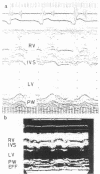Abstract
A 49-year-old women with congestive heart failure and heart block died of cerebral embolism. Clinical and echocardiographic findings suggested a diagnosis of atypical dilated cardiomyopathy with predominantly right ventricular involvement. At necropsy, all the cardiac chambers were slightly dilated and the interventricular septum and the left ventricular wall were of normal thickness and symmetry. Histological examination, however, disclosed extensive disarray of abnormal myocardial tissue, especially in the interventricular septum. Her father had similar clinical and echocardiographic findings, while one of her brothers had typical hypertrophic cardiomyopathy at necropsy. It is likely that the patient actually had inherited hypertrophic cardiomyopathy. The case illustrates the difficulty in diagnosing hypertrophic cardiomyopathy when based solely on the left ventricular gross anatomy.
Full text
PDF



Images in this article
Selected References
These references are in PubMed. This may not be the complete list of references from this article.
- Clark C. E., Henry W. L., Epstein S. E. Familial prevalence and genetic transmission of idiopathic hypertrophic subaortic stenosis. N Engl J Med. 1973 Oct 4;289(14):709–714. doi: 10.1056/NEJM197310042891402. [DOI] [PubMed] [Google Scholar]
- Das S. K., Cassidy J. T., Dodson V. N., Willis R. W., 3rd Antiheart antibody in idiopathic hypertrophic subaortic stenosis. Br Heart J. 1973 Sep;35(9):965–969. doi: 10.1136/hrt.35.9.965. [DOI] [PMC free article] [PubMed] [Google Scholar]
- Ferrans V. J., Morrow A. G., Roberts W. C. Myocardial ultrastructure in idiopathic hypertrophic subaortic stenosis. A study of operatively excised left ventricular outflow tract muscle in 14 patients. Circulation. 1972 Apr;45(4):769–792. doi: 10.1161/01.cir.45.4.769. [DOI] [PubMed] [Google Scholar]
- Goodwin J. F., Oakley C. M. The cardiomyopathies. Br Heart J. 1972 Jun;34(6):545–552. doi: 10.1136/hrt.34.6.545. [DOI] [PMC free article] [PubMed] [Google Scholar]
- Henry W. L., Clark C. E., Epstein S. E. Asymmetric septal hypertrophy. Echocardiographic identification of the pathognomonic anatomic abnormality of IHSS. Circulation. 1973 Feb;47(2):225–233. doi: 10.1161/01.cir.47.2.225. [DOI] [PubMed] [Google Scholar]
- Maron B. J., Roberts W. C. Quantitative analysis of cardiac muscle cell disorganization in the ventricular septum of patients with hypertrophic cardiomyopathy. Circulation. 1979 Apr;59(4):689–706. doi: 10.1161/01.cir.59.4.689. [DOI] [PubMed] [Google Scholar]
- Maron B. J., Sato N., Roberts W. C., Edwards J. E., Chandra R. S. Quantitative analysis of cardiac muscle cell disorganization in the ventricular septum. Comparison of fetuses and infants with and without congenital heart disease and patients with hypertrophic cardiomyopathy. Circulation. 1979 Sep;60(3):685–696. doi: 10.1161/01.cir.60.3.685. [DOI] [PubMed] [Google Scholar]
- Redwood D. R., Scherer J. L., Epstein S. E. Biventricular cineangiography in the evaluation of patients with asymmetric septal hypertrophy. Circulation. 1974 Jun;49(6):1116–1121. doi: 10.1161/01.cir.49.6.1116. [DOI] [PubMed] [Google Scholar]
- Yamaguchi M., Toshima H., Yanase T. Genetic heterogeneity of idiopathic cardiomyopathies. Jpn Circ J. 1978 Oct;42(10):1131–1132. doi: 10.1253/jcj.42.1131. [DOI] [PubMed] [Google Scholar]
- ten Cate F. J., Roelandt J. Progression to left ventricular dilatation in patients with hypertrophic obstructive cardiomyopathy. Am Heart J. 1979 Jun;97(6):762–765. doi: 10.1016/0002-8703(79)90012-7. [DOI] [PubMed] [Google Scholar]




